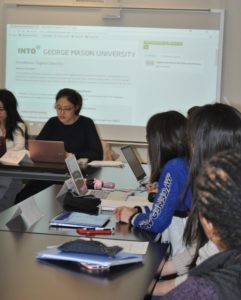PROV 501/502/504 (now INYO 501/502/504): Welcoming the World to Mason
Renowned as a culturally-diverse international University, George Mason illustrates its commitment to that distinction through the INTO Mason joint venture. The INTO Mason pathway programs were created to help transition students with a high school diploma or an undergraduate degree from schools and universities outside the U.S. as they pursue their degrees at George Mason.
A multilingual and diverse group of more than 300 students arrive at Mason annually  to pursue a variety of graduate programs (along with another 200 or so who arrive to pursue undergraduate degrees at Mason). INTO Mason provides the language and cultural skills necessary to succeed in the American university setting. “Our [INTO Mason] program is almost without parallel in the U.S.,” explains Steven Harris-Scott, PhD in History and Program Manager for INTO Mason’s Graduate International Pathways program. (In fact, INTO Mason is also responsible for the increase in international enrollment over the past few years.) “At Mason, we’re driving the bus on transitioning grad students from their international undergraduate experience to Mason’s graduate programs – we have a vast amount of institutional knowledge about this subject. Only one or two other schools with international pathway programs such as ours even run a course like our PROV/INYO 501/502/504 classes.”
to pursue a variety of graduate programs (along with another 200 or so who arrive to pursue undergraduate degrees at Mason). INTO Mason provides the language and cultural skills necessary to succeed in the American university setting. “Our [INTO Mason] program is almost without parallel in the U.S.,” explains Steven Harris-Scott, PhD in History and Program Manager for INTO Mason’s Graduate International Pathways program. (In fact, INTO Mason is also responsible for the increase in international enrollment over the past few years.) “At Mason, we’re driving the bus on transitioning grad students from their international undergraduate experience to Mason’s graduate programs – we have a vast amount of institutional knowledge about this subject. Only one or two other schools with international pathway programs such as ours even run a course like our PROV/INYO 501/502/504 classes.”
When Harris-Scott first taught the course in 2015, the only slightly suitable text that was identified was targeted at undergraduate international students and barely met the minimal needs of a more advanced graduate student. In order to properly fill the students’ needs, Harris-Scott and the coordinator for the courses, Amy Lewis, concluded that multiple texts would have been necessary, increasing students’ costs substantially. Harris-Scott and Lewis also saw the necessity for course materials to be infused with a cultural understanding of a population from not just one or two foreign countries but, instead, from dozens.
Moreover, with five or more different instructors teaching the various courses at any one time and some turnover from semester to semester, Harris-Scott and Lewis knew they wanted the final course product to be dual-edged: it was imperative that a path for faculty onboarding was incorporated into the platform, as well as a student-facing resource. They also wanted the ability for new faculty to have the ability to contribute their own lesson plans to allow for the courses to grow and evolve.
When the 4-VA grant was awarded, Harris-Scott and Lewis collaborated with other instructors of the courses to create a free online resource of 12 lessons, ranging from learning reflections to academic integrity to critical thinking. The new tool was introduced in the Fall of 2017 and tweaked throughout the Spring 2018 semester. Harris-Scott notes, “We’re still working out some of the elements, especially in response to faculty requests for more latitude and choices within the lessons, but we think we’ve built a valuable resource, which we expect will continue to be fine-tuned each semester. We’re looking forward to seeing this improve and advance with each iteration.”
